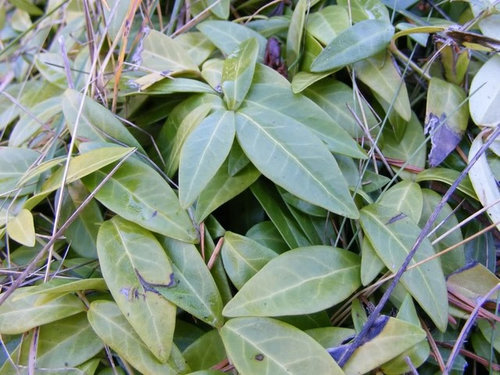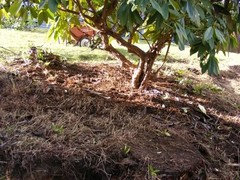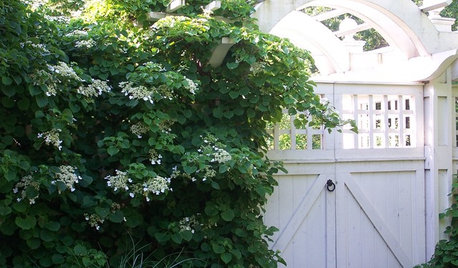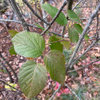How to get rid of this vine/groundcover
We recently bought a house that was previously owned by very old people and it seems that over time they stopped maintaining the yard. There's a great deal of overgrowth everywhere, and I'm planning on overhauling the landscaping to provide more privacy from neighbors and to lend more cohesiveness to the outdoor space.
In order to do that, I must first clear out all of the overgrown stuff that's an eyesore, and in a weather break, we had a 50º day over the weekend and I begun digging out this groundcover vine so I can remove 2 stumps and "get to it" when spring comes along. My method so far has been to use a shovel to "cut through" the thick vine and root mass and then pull sections of it up like a thick sod. DH suggested just laying landscaping cloth down to "kill" it, but that seems like the lazy and "wrong" way to do it, which will ultimately result in the vines growing back through it, and the landscape cloth showing through under bark over time. It seems like I'm removing a LOT of dirt from this area too.
First : What is this?
Second : Am I doing this properly?
Third : Am I doing this the hard way?




Comments (19)
zubababy
15 years agoI don't know what you have there, maybe someone else can answer that. maybe vinca / periwinkle??
We had the same issue with our house when we bought it. We had virginia creeper all over the back beds. Many branches over the fence were dead, it looked horrible.
I removed it the same way that you are....the hard way.
I'm glad that I dug it up and pulled it out. After a couple months went by, I was glad that I missed some by the back fence to grow back again. It just seemed so ugly with all the dead vines, but I've grown to like it when it is kept under control.
On the other side of the bed, I didn't want any of it growing there. I was able to remove it completely from that section. I did have to pull a few more every couple of months that I didn't get pulled out all the way.I think the hard way is the best way in the long run.
Good Luck!
laurell
Original Author15 years agoThank you so much for the ID. The plant seems more evil and scarier than I imagined!
I have part of a bag of caseron that the previous owners left here. Would it be prudent to sprinkle the dug-up areas with it to help kill the roots? I hope to put in quite a few shrubs along this fence line over the course of the spring and summer, so I want to be sure i'm not poisoning them as well.
Thanks!
homemommy
15 years agoHonestly, I don't think it is ugly at all... I would just about die to have this type of ground cover so well established. Perhaps it is just looking a little raggy over the winter period, and the fact it just has not really been nurtured in awhile. But... to each his own.
I would recommend physically removing it as best you can. Then perhaps work in an herbicide a few times. Follow the recommendations of the herbicide you use prior to replanting.
Unless you want to go a more organic route. Then you may want to stick to just hand removal, and covering it. May take all summer! Ah, maybe two... but it can be done!
Might want to see if some of your new neighbours want some, maybe post to your local craigs list or kijiji or even Freecycle that you have "free" groundcover, just "come and get it!" "Bring shovel!" Beauty is in the eye of the beholder afterall! lol.
As for the amount of dirt you are removing, I would suggest pulling it up, setting the dirt / plants aside on a tarp for a few days to dry out, and then you will probably have better luck shaking the extra dirt off!!
hortvet20yrs
15 years agoI specialize in landscape maintenance and many of my customers have vinca as groundcover. It is primarily used as a groundcover because it does produce a nice flower in the spring. I personally don't like it because it never (rarely) grows thick enough to discourage weeds.
We use round-up to eradicate hard to kill weeds in the vinca and the vinca is very suceptible to the round-up. To kill ALL the vinca you would have to coat as much leaf surface as possible while the plant is actively growing. Round-up should only be used to coat the leaves and should not be applied to the point of run-off. Plants absorb round-up on their leaves much like we would absord something on our skin. Once absorbed it is tranlocated through-out the plant and kills the plant at the root. These planting areas look like they were once well established and it may take a couple applications. Read the label to time the applications correctly. Too much or too often is not a good thing because if the plant is already stunted or unhealthy then it is unable to correctly process the toxins and the product (and your time) are wasted. Round-up does not stay in the soil and would have no effect on a later planting.
The vinca may come back in places after the initial applications but you can dig out the small patches or spot treat if it is not too close to viable plants. If you don't like pesticides you can keep digging. Vinca is relatively shallow rooted but you are still removing much soil from your planting area. It would take a long time to kill this plant by covering it up.
The plants probably look somewhat yellow because if there were trees there before they were providing shade and vinca prefers shade. It gets that washed out yellow look in full sun.
I live in zone 5 (Central Indiana) and we don't start spraying round-up until late april and early may because most plants aren't actively growing yet.
I hope this helps. Round-up is a brand, there are generics, you just need the active ingredient of glyphosate. Sometimes if you buy the concentrates you can mix it a little heavier then what they provide with the pre-mixed container. The heavier rate can make a difference for hard to kill weeds. Still follow the label.smcmullen
15 years agoI had vinca minor growing in a flower bed about 50' long and 12' wide. It's beautiful in the spring, but by July it was pretty ugly. There was no way I could get it all out. About two years ago I laid cardboard over it and put mulch on top. So far so good.
laurell
Original Author15 years agoI have an update and later tonight I'll post photos.
Someone came and got probably 100 square feet of this to cover a hillside in the back of his house. I dug the rest of it up(well, almost). The patch is about 50x15 feet, and I only have probably another 30 square feet to get rid of. I've dug it all out except for around a rhododendron that the vinca attacked. I cut all of the green parts of the vine off, but didn't want to damage the rhody's root system so only pulled out what came easily. I'm not sure if caseron will make it difficult for it to put out green parts (it's a pre-emergent, but i'm not sure if that just gets seeds). If it will work, I'll lay some of that down around the base of the rhody, then cover it with 1-2 layers of cardboard and a thick layer of mulch and leave it like that for a few years. I hope this will take care of it. As for the rest of the area, since I no longer have any soil and want to plant things, I'm going to rake up as many of the remaining roots that I can find, lay down a couple layers of newspaper, then soil, then plant my large shrubs, another layer or newspaper or cardboard, followed by mulch until next spring when I start actually doing landscaping.
Does that sound like a reasonable plan?
laurell
Original Author15 years agook, so these are the photos of the wreckage. I was going to go out this morning and tidy things up and pull/dig the last bits of vinca out, but mother nature has other plans and it's raining today. Plus I'm pretty sore.
Here's the mass under that rhododendron

And a stump I discovered

This is what I have left over after trimming everything back. The green piles are stuff that's been cut/pulled, not attached to the ground


The last big that I still need to dig up

The pile of rubble


{{gwi:20824}}morz8 - Washington Coast
15 years agoLaurell, casoron is a pre emergent, one of the products meant to prevent germination of seeds. This one does seem to have some residual effect though and should be used with caution - it can be injurious to bulbs, tubers (dahlias, glads, iris), and many herbaceous perennials (those ornamentals that die to the ground over winter). Your property looks reasonable level - a friend of mine used casoron on a slope on Mercer Island and rain washed it into what must have been larger concentrations at slope bottom, killing her azaleas.
Casoron would have little effect on an evergreen groundcover like vinca.
Rhododendrons are somewhat easy shrubs in our climate, but they do have a fine, dense network of surface feeding roots that extend out as least as far as the widest branches. You don't want to cover those with cardboard or overly deep layer of mulch - the surface roots (almost like a big pancake) can't function when buried too deeply. You don't want to dig into the surface roots to remove the vinca either.
I'm not usually one to resort to chemicals in my garden, but cutting the vinca back under the rhododendron, carefully and lightly spritzing any new vinca shoots when growth begins again with Roundup may be the way for you to go.
It looks like you are making progress in great leaps and you've clearly been working hard...just remember, it's still winter :) The landscaping didn't become this way overnight, and it's going to take you some time to renovate it. I hope you don't resort to the landscape cloth mentioned in the first part of your post as a shortcut, most who have used it have come to regret it over time.
harryshoe zone6 eastern Pennsylvania
15 years agoLeaving a little vinca to grow under the rhododendron might be a good compromise. They seem to be happy together currently. You could simply control the vinca beyond the drip line. It would save a lot of work and maybe your rhody as well.
laurell
Original Author15 years agoI certainly won't be using landscape cloth. Every time I've ever done work in someone's yard that's used it, it's coming up in places and looks terrible. Plus it'll be hard to plant through, and I have a great deal of planting planned in the future.
I also am not willing to compromise to make this easier. I'd rather do things the way I want them and not be constantly battling an invasive vine that I don't like at all.
Would hitting the rhody with a time release fertilizer and then setting presoaked cardboard or newspaper down then mulching lightly and watering heavily work? I'd prefer not to poison my plants, but if I have to, I'll damage or kill this rhododendron (I have 5 more and I'm not very fond of them, but they're the only mature shrubs in the yard) to get rid of the vinca. I probably sound crazy like I'm on a war path, and that's mostly because I am.
morz8 - Washington Coast
15 years agoRhododendrons have a low nutritional requirement compared to many shrubs...when grown in our naturally acidic soil they rarely need fertilizer. Mine have had only top dressing with compost over many, many years and haven't shown any symptoms they need anything else.
The rhododendron won't respond well to the cardboard or even a newspaper mulch within the drip line of the branches and you can't offset that with a supplemental fertilizer. It isn't necessary to sacrifice the shrub to eliminate the vinca - you just may not be able to take care of it in one fell swoop like you imagine. The vinca is stubborn, but not as tough as any determined gardener.
Dig it out where you can, pull anything that sprouts from pieces of missed roots or rooting stems (you'd have to sift your soil to get it all), and in areas where you can't dig it, cut it back to the soil and use small amounts of Roundup - with caution and a light hand - after growth resumes when the weather warms up.
It wouldn't be hard to imagine you finding bits and pieces of the vinca trying to regrow for the next couple of years. Pull them out as you do your regular maintenance and weeding and it will eventually give up. I think you'll find when you've become more familiar with your garden over a couple of seasons that consistency and patience will pay off for you.
tbenton
5 years agolast modified: 5 years agoMany years ago I bought a hanging plant mixture that had a small piece of variegated vinca vine in it and it was hanging over my large shade/rock garden right in front of the house. Somehow it managed to 'get out ' of the pot and filled the entire shade garden that is enclosed with landscape timbers and it sneaks out of there and then it showed up 20 feet away around a brick tree well and it has spread all over the place. It climbs up and gets in my planted whiskey barrels and I have to keep yanking it out. I have gladly given it away over the years to friends who had hilly areas that they could not mow and needed good ground cover and when we pull it up we destroy it but it still comes back and we can't keep up with it. My husband just pulled up and used a hedge trimmer on a large area of it right near our front door between the grass and the tree well and what is now dirt 'looks' clear of it but I know it will be back. We want to put down grass seed in that area but I would like to treat the ground to kill the roots of the devil vinca but NOT with vegetation killer as it could run off and kill the grass and its not 'plantable' for a year. I only use that stuff in our gravel driveway. Will Round Up work if I spray it on the dirt and/or will Preen work? Getting desperate now that he has done such a nice job clearing it out in that one area.
We are not interested in applying cardboard or cloth,etc to that area to try to stop it from coming up. We are as 'green' as we can be but in this case...CHEMICALS please.
Cracks me up every year when I go to the nursery to get my flowering plants and they charge $5 or more for a pot of variegated vinca. There should be a warning sign posted...lol..... OR I should go into the vinca business.
Advice please
Terri
NHBabs z4b-5a NH
5 years agoPreen is a pre-emergent which means that it acts on seed to prevent their ability to grow into plants. So it won't do a thing for your vinca which is already plants with roots, even though you cut it back to the ground, but it might prevent your grass seed from sprouting. Roundup needs to be sprayed on leaves, so you will need to wait until the vinca plants regrow leaves and then spray it. Spraying on the dirt won't do a thing. You could try a lawn weed and feed product since those are geared to kill broad-leafed plants.
tbenton
5 years agoThanks NHBabs...I found a product Bayer Brush Killer that has the chemical in it that is recommended for VInca and does not hurt grass so what the heck...going to try that. Hubby said he tried real hard to get the roots of all he vinca but agreed that is a fool's errand. Its been two weeks and so far no vinca poking up thru the dirt so time will tell.
NHBabs z4b-5a NH
5 years agolast modified: 5 years agoThe brush killer also needs leaves to work, so don't spread it on the ground. I would also look up the length of time this herbicide remains active using its scientific name since you plant to replant the area at some time. Some herbicides have a relatively long active life. Regardless, use proper precautions in using any herbicide: gloves, long sleeves, eye protection, and wash up well afterwards.
I have been rooting out Vinca over the past year or so, and most of it isn't resprouting, though a few sprigs are that I then remove.
tbenton
5 years agolast modified: 5 years agoI have done some extensive reading on the brush killer I always follow all precautions with any chemical. I was thinking that the brush killer sprayed on the dirt would go down and kill the vinca roots. I have plenty of leafed out vinca adjacent to where hubby stopped pulling/cutting around the brick/concrete deep tree well to spray and see what happens We have a 'country' yard in ruralurbia and have all sorts of invasive stuff growing so have lots of places to use the brush killer. This is the first time we have actively attacked the vinca that encroached into the yard itself. Funny how everything that we don't want just flourishes. I can also use the brush killer on the little violets that are taking over areas under some shade trees. We have dozens of huge old trees.
louis de paris
5 years agohello everyone,
3 options are available:1. the covering of the soils with special tarps
2. torching 2-3 sec long the weedshttp://www.infosglyphosate.com/les-desherbeurs-thermiques-une-alternative-ecologique-au-glyphosate/
3. using boiling water / steam on weedshttp://www.bioalaune.com/fr/actualite-bio/36122/oeliatec-entreprise-bretonne-detrone-glyphosate
sorry, those pages are not in english but could be usefull :)



















david_page77